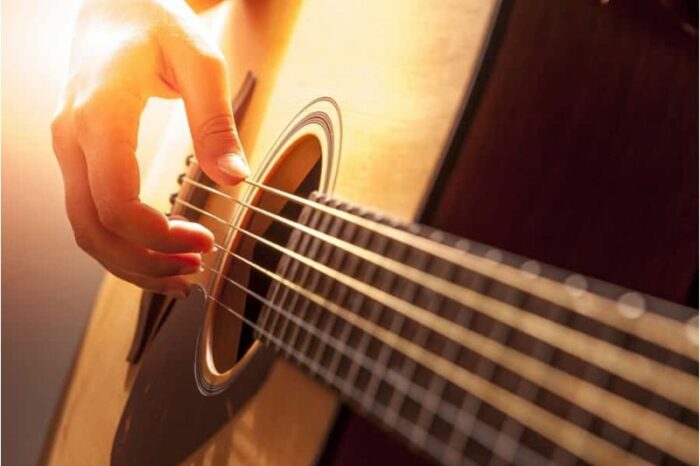The classical guitar is an instrument that has captivated musicians. It gives a completely unique blend of melody and rhythm. Whilst you learn classical guitar, you discover the rich history of it. It gives a classical guitar-playing basis.
How to Learn Classical Guitars
Here are ways to learn one:
Choose the right classical guitar
Choosing the right classical guitar is vital. There are factors to consider, such as:
- Types of wood. The wood used in classical guitar construction is spruce and cedar for the top (soundboard). Rosewood or mahogany are good for the back and sides. Your choice of wood varies on your preference. Also, it depends on the desire of your sound.
- Size and shape of the guitar body. Classical guitars range from 1/4 size for young children to full-size instruments for adults. Choosing a comfortable guitar that suits your body size and playing style is important.
- Quality of craftsmanship. A well-made guitar will have a balanced tone, good projection, and smooth playability. Try out exceptional guitars before creating a buy, or seek advice from a professional guitarist.
Basic guitar techniques
To learn classical guitar, it is vital to know the fundamental tactics of the instrument. These techniques include:
- Proper hand positioning is vital for achieving a clean and articulate sound. The right hand should use the guitar technique of fingerpicking, where each finger is assigned to a specific string. This allows precision when playing guitar chords.
- Arpeggios are the blocks of classical music theory. Practicing these will develop your finger strength. It is vital to begin with simple exercises when you play classical guitar.
- Legato playing involves playing notes smoothly and connected, without any breaks or pauses between the notes. This technique necessitates control. It includes particular finger actions and a sensitive touch at the strings.
Build a practice routine
Consistency is prime while learning classical guitar. It is vital to establish a regular practice routine to make steady progress. Set aside dedicated practice time each day, even if it is just for a few minutes. This will help build discipline. Additionally, makes practicing a habit.
When creating a practice routine, divide your practice session into different sections. Begin with warm-up physical activities. This is to lighten up your arms and prepare your muscle tissues for playing. Then, work on specific techniques or pieces that you are currently learning.
Break down difficult passages into smaller sections and practice them slowly, gradually increasing the speed as you improve.
Learn classical guitar repertoire
When selecting repertoire, start with pieces that are suitable for your current skill level. Gradually progress to a more challenging repertoire as you improve. Choosing pieces that you enjoy and resonate with you is crucial. Studying the works of renowned classical guitar composers such as Fernando Sor is also beneficial. His compositions are cornerstones of classical guitar repertoire.
Discover ways to examine sheet music
Classical guitar frequently includes studying sheet music. Get yourself up to speed with musical notation and rhythms. This skill opens up a repertoire of portions to explore.
Find a classical guitar teacher or online resources
Having guidance from a classical guitar teacher can accelerate your learning.
Here are ways to choose one:
- Research local music schools and studios
- Get referrals and recommendations
- Reach out to fellow musicians, friends, or family members who might have recommendations for classical guitar teachers
- Attend performances and workshops
- Schedule free classical guitar lessons
If you are unable to find a local classical guitar teacher, there are online resources available that can supplement your learning. Online video lessons can provide insights and instruction. However, it is important to approach online resources cautiously to ensure they are reputable.
Common Mistakes Made By Classical Guitarists
When playing the classical and acoustic guitar, a certain elegance and grace comes with it. However, even the most talented guitarists can fall into the trap of making some common mistakes.
- Poor left-hand positioning. It’s vital to ensure that your fingers are properly placed. Remember not to press down on adjacent strings. Keeping your wrist straight and maintaining the correct finger will enhance your playing accuracy.
- Neglecting right-hand technique. While the left hand manages the notes and frets, the right hand is responsible for creating the tone. Neglecting the right-hand technique can lead to uneven sound production.
- Skipping finger independence exercises. A classical guitarist often faces challenges with finger independence.
- Rushing through pieces. A common mistake among guitarists, regardless of their level, is rushing through pieces. Playing classical guitar at a faster tempo than you’re comfortable with often results in mistakes and inaccuracies.
Wrap-Up
Studying classical guitar is a great journey. This requires dedication and passion. It is a manner to encourage and praise you with a deep appreciation of the tune. So, choose your guitar and embark on this musical adventure.


